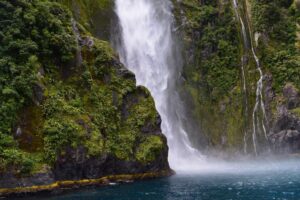
Pure Elixir: Exploring the Wonders of Mountain Spring Water
Introduction:
In a world where the quest for purity and well-being is paramount, the source of our water plays a pivotal role. One of nature’s most exquisite gifts is mountain spring water, a pristine elixir that flows from high-altitude sources, encapsulating the essence of purity and freshness. In this article, we delve into the wonders of mountain spring water, exploring its origins, unique qualities, and the impact it has on our health and the environment.
The Origin Story Mountain Spring Water:
Mountain spring water is born at the highest elevations, where rain and snowmelt percolate through layers of rock and soil, gradually making their way to the surface. These sources are often nestled in remote, untouched landscapes, far from the pollution and contaminants that can taint water in lower altitudes. The journey through the earth imparts essential minerals, contributing to the water’s unique composition.
Purity at its Peak:
One of the most alluring aspects of mountain spring water is its unparalleled purity. As the water filters through layers of rock, it undergoes a natural purification process, leaving behind impurities and acquiring minerals that enhance its taste and health benefits. Unlike water from urban sources, mountain spring water is free from the pollutants that can compromise the quality of water, offering a clean and refreshing experience with every sip.
Mineral Composition:
Mountain spring water is rich in minerals that are essential for the human body. Calcium, magnesium, potassium, and trace elements are naturally present in varying concentrations, providing not only hydration but also contributing to overall well-being. The balanced mineral composition is one reason why many people prefer mountain spring water over other sources, as it offers a harmonious blend of taste and nutritional value.

Taste and Aroma:
The unique geological characteristics of the regions where mountain spring water originates play a crucial role in shaping its taste and aroma. The presence of minerals gives the water a crisp and refreshing quality, with a subtle sweetness that distinguishes it from other types of water. Connoisseurs often describe mountain spring water as having a clean, pure taste, devoid of any unpleasant aftertaste that can be associated with water from less pristine sources.
Health Benefits:
Beyond its exquisite taste, mountain spring water boasts a range of health benefits. The natural filtration process through rocks and soil ensures that harmful contaminants are left behind, providing a safer alternative to tap water in many regions. The mineral content not only contributes to the water’s taste but also supports various bodily functions. For instance, calcium and magnesium are vital for bone health, while potassium aids in maintaining proper electrolyte balance.
Hydration and Detoxification:
Proper hydration is essential for overall health, and mountain spring water serves as an excellent source of pure hydration. Its high-quality composition makes it an ideal choice for those seeking to detoxify their bodies and promote optimal wellness. By choosing mountain spring water over other options, individuals can support their bodies in flushing out toxins and maintaining a healthy fluid balance.
Environmental Impact:
The journey of mountain spring water from the depths of the earth to its emergence at the surface is a testament to the interconnectedness of nature. These pristine sources are often located in protected environments, contributing to the conservation of biodiversity and the preservation of delicate ecosystems. Choosing mountain spring water with sustainable and ethical practices ensures that this precious resource is protected for future generations.
Sustainability and Responsible Sourcing:
As the demand for mountain spring water grows, it is crucial to address the environmental impact of extraction and bottling. Responsible sourcing practices involve ensuring that water is collected sustainably, without depleting local water sources or harming the surrounding ecosystems. Some companies are taking steps to minimize their carbon footprint by using eco-friendly packaging and investing in initiatives that contribute to environmental conservation.

Challenges and Considerations:
While mountain spring water is celebrated for its purity, there are challenges associated with its extraction and commercialization. Over-extraction can lead to a depletion of local water sources, affecting ecosystems and the communities that rely on them. Additionally, the environmental footprint of bottling and transportation needs to be carefully managed to mitigate the impact on the planet. Consumers can play a role by choosing brands that prioritize sustainability and transparency in their practices.
Conclusion:
Mountain spring water is more than just a thirst-quenching beverage; it is a testament to the beauty and purity of nature. Its journey from the mountaintop to our glasses involves a natural filtration process that imparts unique qualities and benefits. Beyond the delightful taste, mountain spring water offers a source of hydration that is rich in minerals and free from the contaminants that can be found in water from less pristine sources.
As consumers, our choices matter. Opting for mountain spring water from responsible and sustainable sources not only enhances our well-being but also contributes to the conservation of fragile ecosystems. In a world where the importance of environmental stewardship is increasingly recognized, embracing the wonders of mountain spring water is a step towards a healthier, more sustainable future.


